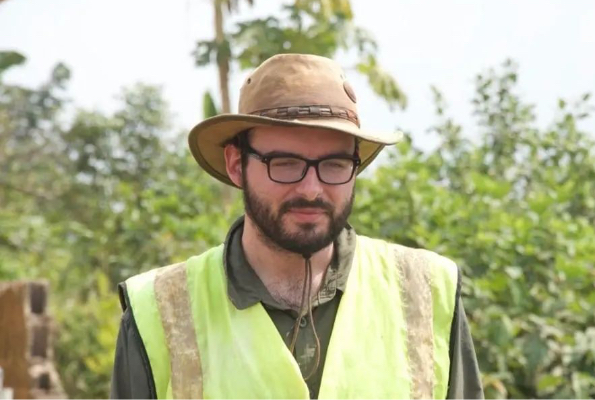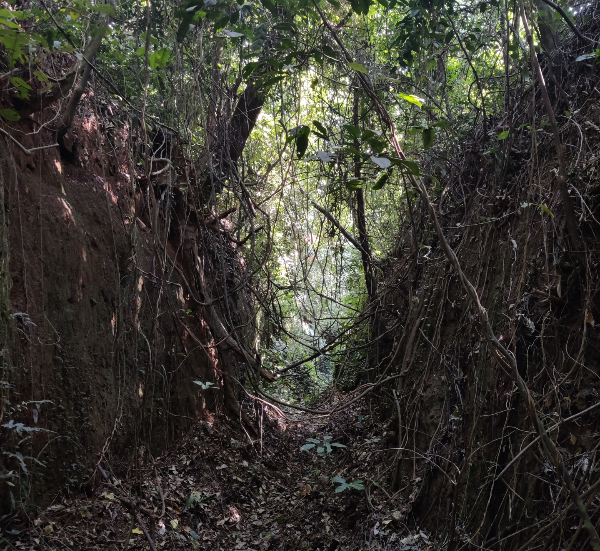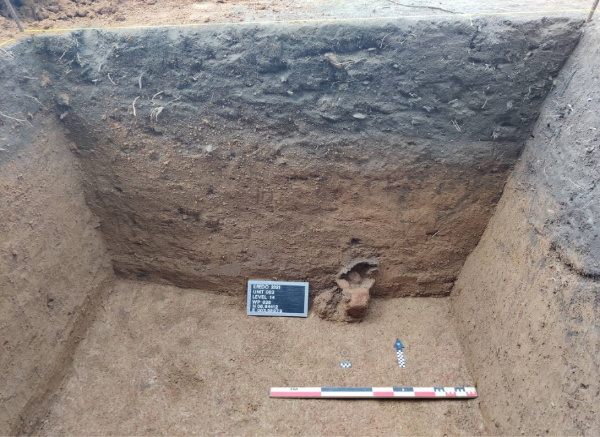Ph.D. Candidate Tomos Evans Awarded Wenner-Gren Dissertation Fieldwork Grant

6th year Ph.D. Candidate Tomos Llywelyn Evans was recently awarded a prestigious Wenner-Gren Foundation Dissertation Fieldwork Grant, which will be used to fund his archaeological research at Sungbo’s Eredo, a monumental earthwork in southwestern Nigeria, in 2023. The Eredo, at 100-miles in its circumference, is argued to be Africa’s largest single structure, and has been the focus of research by the Ife-Sungbo Archaeological Project. The project is a research partnership between Nigerian and international institutions, and since 2015 has conducted research at the Eredo in Lagos State, generously supported by the communities of Augustine University, Eredo Village, and the royal palace of Ilara-Epe. Tomos runs his own collaborative project under the umbrella of this larger initiative, and has led several field seasons in southern Nigeria since 2018. Most recently, he completed fieldwork here funded and supported by the Royal Anthropological Institute, London, and Explorers Club Washington Group in 2021-22 in collaboration with Nigerian Ph.D. student colleagues Emmanuel Adeara and Stanley Osinachi Nwosu.
In this spotlight article, Ph.D. Student Graham Callaway asks Tomos about his ongoing work at Sungbo’s Eredo, discussing the nature of earthwork landscapes in this region, and the changing ways that successive local communities have engaged with and conceptualized them over time.
What was your background prior to enrolling at William and Mary? How did you come to focus on African archaeology?
I began my undergraduate studies in Archaeology and Anthropology at the University of Cambridge. I had been fascinated by these disciplines for a long time due to their creative blending of humanistic and scientific methods, and their willingness to go places that were often unreachable by more conventional historical approaches. Cambridge offered wonderful classes on African archaeology (both Pleistocene and Holocene) which revealed to me the incredible range of past societies across the continent, often marginalized in popular and academic discourse in the Global North. My focus on African archaeology has always been aimed at bringing to light further evidence of these societies – their technological expertise, artistic creativity, and evolving ways of perceiving and interacting with the world. Following archaeological and cultural heritage work in southern and eastern Africa, I undertook an MA in African Studies with Heritage at University College London. It was during my studies here that I became fascinated by the spectacular archaeology of Nigeria. Soon after, I joined the Ife-Sungbo Archaeological Project that’s partly based here at William & Mary after having had conversations with Professor Gérard Chouin. I am now co-supervised by him and Professor Neil Norman, two leading experts on earthwork studies in Africa!
Can you give us a general overview of your research on the Sungbo's Eredo earthworks? What are they and what questions do you hope to answer there?
Sungbo’s Eredo is an enormous linear earthwork composed of large banks and trenches in southwestern Nigeria and associated with the Ìjèbú Kingdom, which existed here from at least the 15th century AD, when it was documented by Portuguese travelers. Local oral tradition suggests that the Eredo was constructed by a powerful ruler called Sungbo, as a sort of memorial to herself. My research explores when, how, and why this unprecedented monumental earthwork was constructed and engaged with by the communities of this region as part of a wider, associated spiritual landscape. My project largely blends archaeological and archival work, as well as surveys of shrines and other meaningful sites of local memory in the contemporary landscape, to gain something of a long-term perspective on evolving local engagements with, and conceptualization of, Sungbo’s Eredo.

You have described Sungbo's Eredo as “a monumental composition within its broader landscape.” Can you elaborate on what this means and the importance of these ideas to your work?
The concept of “composition”, as I use it, is documented in a range of historical and ethnographic writing on West and Central Africa. But it’s perhaps Jane Guyer and Samuel Eno Belinga in their famous article in 1995 (Wealth in People as Wealth in Knowledge: Accumulation and Composition in Equatorial Africa) who offer the most detailed description of it. The crux of this idea is that many Central and West African societies have typically valued the bringing together of different agencies and bodies of qualitative knowledge – of people, material objects, spiritual entities etc. – synergizing them into new combinations that act upon the world in novel ways. Guyer and Belinga describe the ways in which such logics manifest in social organization in Central Africa. Here, effective rulership is often that which successfully accumulates and brings together the qualitatively distinct skills, knowledge, and practices of different individuals and collectives into synergistic composites, where the different “parts” of the whole are interdependent and constantly interacting. Similarly, study of West African architectural practices has shown the creation of earthen architecture to be a complex process involving the composition of knowledge and abilities of different architects, craftspeople, spiritual entities, and associated ritual medicines to ensure successful construction. I’m looking to investigate the extent to which such widespread concepts of wealth-in-people, wealth-in-knowledge, and composition are manifest in, and actively shaping, the monumental landscape. This can shed light on the ways that monumental and shrine features may have accumulated in synergistic ways that were seen to empower Sungbo’s Eredo to achieve and enact its essential purpose(s) within Ìjèbú society. I’m foregrounding the diachronic aspects of these processes: how they transformed this landscape throughout the course of West African history.
You note that previous work with African earthworks has usually interpreted them as relating to defense, prestige, political consolidation, and religion. How does your work bring a different perspective to this topic?
The main dimension of my analysis that I feel has been previously underutilized is greater consideration of the ways in which successive Ìjèbú communities conceptualized the earthwork according to their own worldviews. This is aimed at moving beyond ethnocentric terminologies and assumptions. For example, when scholarship considers “defensive” walls, it typically assumes physical, military defense, such as against attacking armies or raiding groups. While this is certainly likely, it’s important to also consider what specific ways local people thought about such concepts as “defense” or “regulation” in this region over time, and where these overlap with and/or diverge from more normative approaches in the social sciences. For instance, ethnographic evidence across Yorùbá-speaking regions (and beyond) shows that people protected and regulated the thresholds of their houses and compounds from more than just “physical” invasion. Such thresholds were also considered bulwarks against dark powers from beyond the dwelling, such as forms of disease and misfortune, with shrines to liminal deities such as Èsù playing a role in that protection. Such threshold logics were applied to a multitude of scales (not only those of the household) including those of town walls and enclosures. We need to similarly problematize notions such as “prestige” to consider how such concepts would have been imagined here, and connected to potentially very distinct notions of society and being.
What relationships do nearby settlements have to Sungbo's Eredo, and how have these relationships changed over time?
The earthwork shows evidence of continued modification by local communities. You can see areas where mounds and causeways were added to it, and new entryways opened through it, said to have been regulated by toll gates and associated shrines. Monumental discard mounds are also observed to cluster around certain parts of the earthwork. Our excavations of a couple of these revealed interesting patterns in which successive generations of local people piled up discard in the same spaces, sometimes on top of earlier collapsed architectural features. Gradually, these features became large monumental structures of the earthwork landscape. Our excavation revealed them to be full of local ceramics, European manufactured wares, cowrie shells, coins, gin bottles, beads, animal bones, giant snail shells, and various other objects. These would have demonstrated the accumulated wealth and evolving identities of the compound communities that discarded them, reflecting aspects of their occupation, consumption, and connections with the land. Locals and incoming travelers crossing the Eredo would have observed these monumental mounds as they moved through this landscape.

How do local people living near the earthwork today understand it? Do these perspectives influence your work?
Today, the Eredo is understood in a multitude of ways by different individuals and groups in this area. Newcomers to the region are often unaware of its existence, and this has led, in places, to the destruction of areas of the bank to make room for agriculture or to acquire materials and space for construction. This is something that a collaborative project – which William & Mary is taking a leading role in – is seeking to combat via digital preservation (using LiDAR) as well as local workshops aimed at brainstorming on-the-ground methods with various stakeholders. However, there are other communities to which the earthwork is of significant cultural and/or spiritual importance. To them, the Eredo landscape represents an important combination of key loci in community life including sacred shrines to several òrìsà (“deities”). As a recognized National Monument, it’s also a useful source of income for local stewards due to the domestic tourism that it attracts from nearby Lagos and elsewhere. Furthermore, oral tradition has at times linked the character of Sungbo to the Quranic/Biblical Queen of Sheba, considering the earthwork more of a memorial than a political or spiritual boundary, and my research explores the ways in which Sungbo and the Eredo came to be viewed in this way. These ideas are an important influence on my work: on the one hand they offer clues into some of the potential deeper-time uses of the Eredo, and on the other may reveal the changing material practices and interpretations of the earthwork landscape over time, and how it continued to act upon (and be acted upon by) local communities over the centuries and up to the present day.














